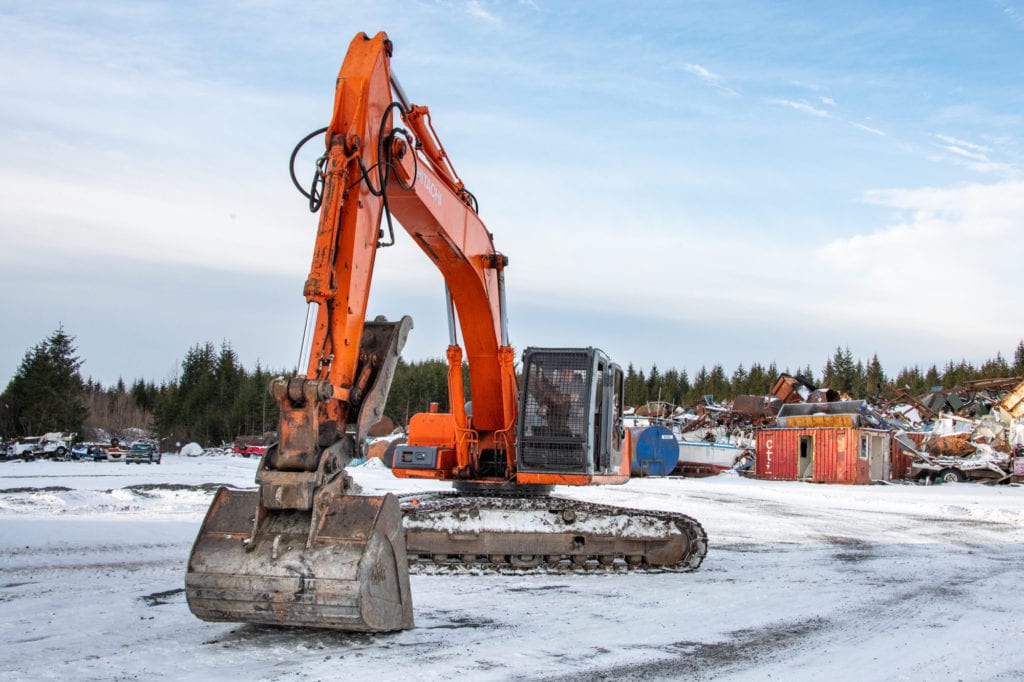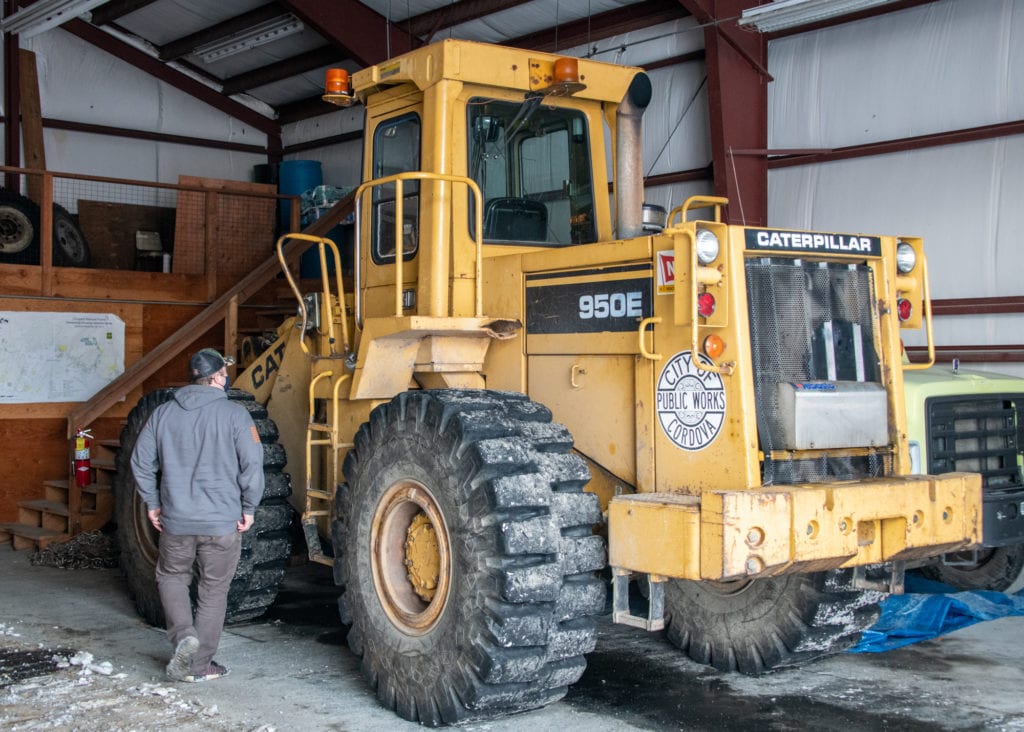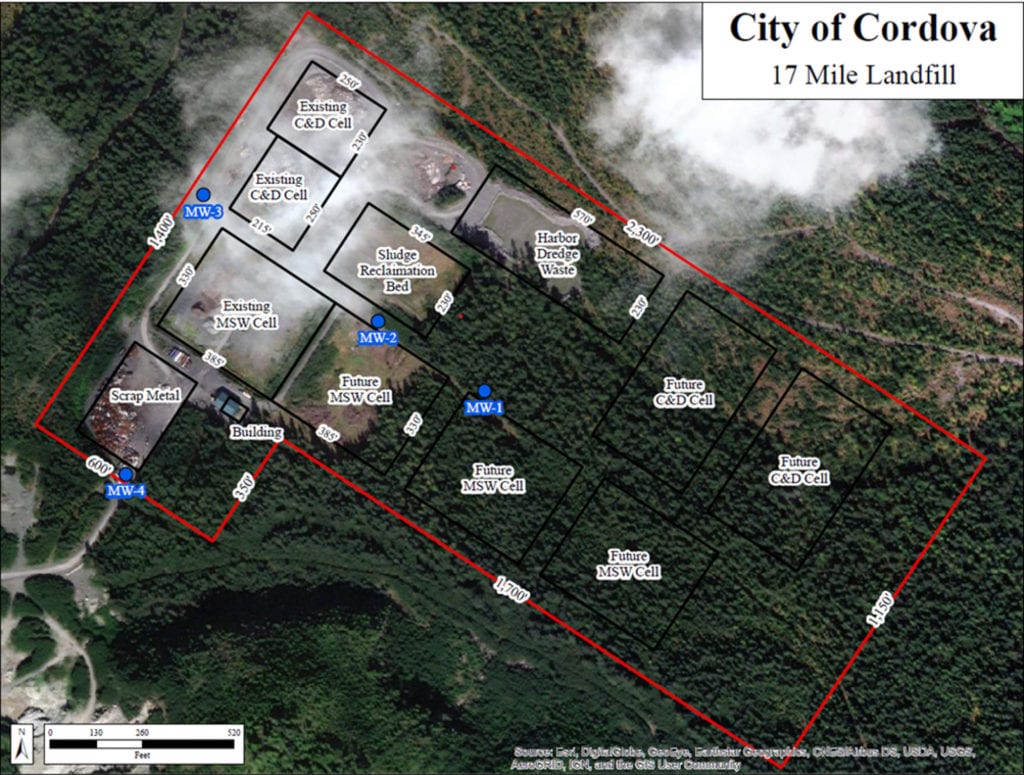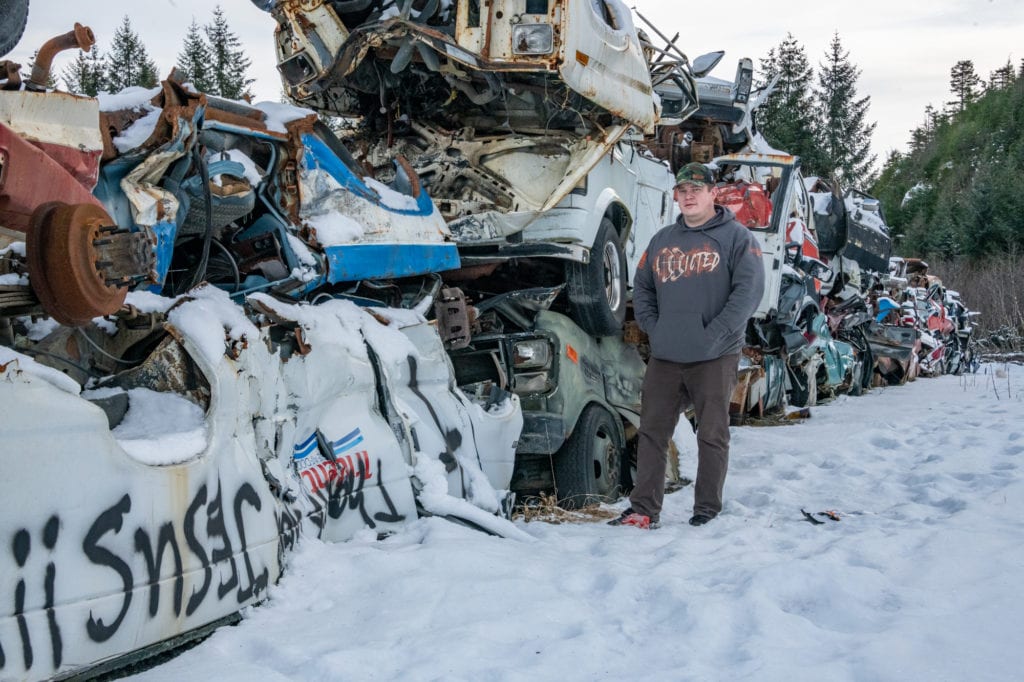
Refuse superintendent Aaron Muma began working at the Cordova landfill in 2002. Nineteen years later, he’s still driving the same vehicles.
Cordova’s surprisingly picturesque 60-acre landfill, located near mile 17 of the Copper River Highway, is the final resting place for most of the city’s trash, from Amazon boxes to asbestos. The landfill is tended by two vehicles, a 2002 Hitachi excavator and a 1988 Cat loader. Dotted with rusty metal fragments, exposed nails and other bits of debris, the landfill is an environment guaranteed to put extraordinary stress on any vehicle.
“There’s a little bit of everything in there: tires, nets, lines, mattresses, all kinds of stuff that likes to get wrapped up in tracks and axles,” said Muma, who manages the landfill.
The landfill excavator must travel at least a half-mile per day, more than typical for a landfill excavator. As a result, the machine’s tracks and rollers have quickly begun to wear down since they were replaced in 2016 at a cost of $60,000. The excavator also lacks functioning wipers, lights and travel speed sensors, all of which were disabled by an electrical fire.
But the excavator seems fresh off the lot in comparison to the city’s 33-year-old loader, which runs on an underpowered four-cylinder engine that limits its ability to climb sloping terrain, and is due for a complete engine and transmission system rebuild. Adding to wear and tear on the loader are its durable but heavy foam-filled tires, which the vehicle wasn’t designed to accommodate, Muma said. Both the excavator and the loader have rusted and cracked rollover protection systems, which can’t be safely repaired by welding.
Fixing the vehicles’ rollover protection systems would mean entirely replacing their cabs, an expensive and time-consuming undertaking. The excavator has accumulated 6,536 hours of use. The loader’s hour meter stopped working several years ago, at 9,510 hours.

Despite their long acquaintance, Muma has few sentimental feelings toward the increasingly decrepit vehicles, whose cramped cabs lack the ergonomic improvements of newer models.
“They’re good pieces of equipment, but that loader is past its usable life,” Muma said. “It’s just barely hanging on… Parts are getting harder and harder to find, so we’re finding ourselves having to fabricate parts and special-order parts more and more.”
The solution endorsed by Muma and Public Works Director Samantha Greenwood is Proposition 1, which will be on the ballot for the March 2 Cordova General Election. Proposition 1 would authorize the city to borrow up to $1.21 million from the Alaska Department of Environmental Conservation to replace landfill heavy equipment. Of this funding, about $1.15 million would be used to purchase a CASE 2021 loader, a CASE 245D excavator and a CASE 2050M dozer, while the remaining $56,695.10 would be used to construct a lean-to for protecting the new equipment, and to purchase additional implements.
The new CASE loader would come outfitted with belly guards, hydraulics guards, solid rubber tires and other features protecting it from the landfill environment.
“Those landfill packages that include guards are not just for the equipment — they protect the operator as well,” Greenwood said.
Able to navigate steeper slopes than the four-cylinder Cat model, the new CASE loader would also aid in snow removal, which lessens groundwater-contaminating runoff. If groundwater standards fall below a certain level, the DEC will require the city to sample its groundwater quarterly rather than twice per year, increasing the yearly cost of mandatory groundwater sampling from $50,000 to $100,000, Muma said.

The new excavator would lack the new loader’s landfill protections, but would be used principally for moving soil. The excavator would only be required to handle garbage in a special area of the landfill used to dispose of asbestos, where the excavator’s gentler and more precise handling abilities would be necessary, Department of Public Works officials said. Purchasing a dozer would allow the excavator to travel less, increasing the longevity of all the vehicles, Muma said.
“I think most people don’t realize how much it costs to run a landfill,” Muma said. “Especially in a small town, people think, ‘Oh, the dump — it’s just a hole that you throw stuff in.’ That’s not the case. It’s very expensive to run a landfill.”
The Public Works Department hasn’t received much comment from the public on Proposition 1, Greenwood said. At a sparsely attended Feb. 4 public presentation, Greenwood said that the DEC’s Alaska Clean Water Fund would be the best place to apply for a loan to reimburse the costs of a new loader, excavator, dozer and other equipment. A 20-year Clean Water Fund loan would come at a 1.5% interest rate and would include a $500,000 subsidy. This compares to a loan from the city permanent fund at 4% interest, or leasing to own from a dealership at a 4.25% interest rate.
The city currently spends an average of $33,000 per year maintaining its landfill equipment — 73% of what it would spend per year repaying a Clean Water Fund loan, once the $500,000 subsidy is factored in. Purchasing new equipment would reduce maintenance to oil changes and other incidental work, Greenwood said. Once new equipment is acquired, the old vehicles will be auctioned off.
“If we don’t get this equipment, in just a matter of time, our loader is going to fail,” Muma said. “It’s going to be a catastrophic failure. If we’re going to maintain DEC compliance, we have to have a loader. So, we will be purchasing a loader, and it will not be at 1.5% interest. It’ll be at 4.5% or maybe even higher. It is, really, in everybody’s best interests that this passes, to keep costs down.”

Cordova recently filled the first of three cells in its landfill, a process which took about 21 years. At this point, the landfill is about 15% full, Muma said. Garbage arriving at the landfill is covered with earth, and the filled cell resembles a gravelly, flat-topped hill with little or no exposed garbage. Muma’s four-man team must keep brush from spreading across areas where garbage dumping is ongoing.
Greenwood and Muma will hold a second public presentation on Proposition 1 from 5:30-6:30 p.m., Thursday, Feb. 25 at the Cordova Center.














